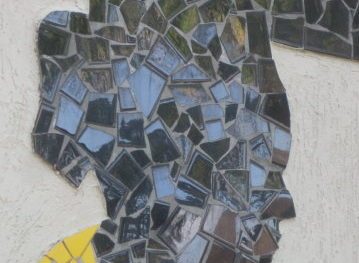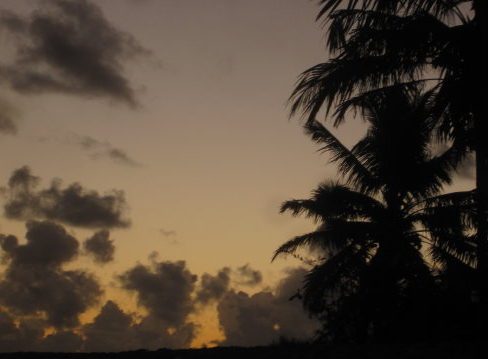Friday–Sunday, Day 104–106

About a week before arriving in Salvador, it occurs to a couple of us that we live far from the beach at home and it might be a good idea to try to find a reasonably-priced guesthouse on one of the famous beaches of Itapoa for our last three days before the final stretch of on-ship days back to the States. We find a good one in the Pousada Encanto de Itapoan and Jill, a nurse practitioner on the ship, and I make reservations to do just that. (I don’t know exactly why, but two of my closest friends on the ship are the two nurse practitioners—perhaps because we all work a fair amount of the time.)
In the morning Jill has to finish-up some on-call duty but then we also visit both the Cidade Baixa (Lower City) and the Cidade Alta (Upper City) of Pelourinho again to see more of the historic structures restored as part of Unesco’s World Heritage Fund program. We find out that the Cidade Baixa has many attractions even though it is more commercial and is deserted at night because there are no residents. (We learn from a knowledgeable cab driver that getting people to come back as residents in the city—and not merely as workplace—is seen as the way to also make the entire city safer. That is a realization Americans have also been slow to come to but when it happens it does seem to make a huge difference.) It is tough to find but there is a particularly nice crafts cooperative—Espaco Solidario–near the base of the funicular that takes workers to and fro the two levels of the city. (The other major way to travel from one level to the other is by an outdoor art deco public elevator known as Lacerda Elevator.) Both the elevator and the funicular—and taxis at night—are the only safe ways to get up to the central historic district. The steep streets known as ladeiros are not safe for anyone to walk through although, again, our taxi driver reports that there are efforts to bring all of those back to life.
I want Jill to have the chance to visit the beautifully restored hospital but it is closed for the day so we plan to come back to see it on Sunday and attend the Cathedral Sunday mass, which is reputed to have very fine music.
The Pousada up near the Farol (Lighthouse) de Itapoa turns out to be a good choice, close enough to the beach to have steady breezes but far enough to be quiet. The taxi cab ride to get there is not terrifying and it is reasonably priced. And the driver seems to understand my Portuguese. How much more can we ask for? We get a lot more: Some of the most beautiful beaches and surf you have ever seen. There are also exceptional restaurants and bakeries within walking distance. Breakfast is exceptional and hearty enough for us to skip lunch. All along the beach are small food kiosks and groups of musicians playing the distinctive sounds and rhythms of Bahian music. Children and adults play volleyball and soccer. There is fishing of all types with amazing hauls of large and small fish.
The Pousada calls the same taxi cab driver for us and he picks us up for the return drive back to town on Sunday. Once again, he gives us explicit instructions on how to stay safe and then he is off to the beach himself, followed by plans to attend one of the most important soccer matches in Brazil that same evening—the one between Bahia and Vitorio that will determine which team goes to the upcoming World Cup finals in South Africa. The soccer game starts at 10pm when it is cooler and everyone’s had a good day at the beach and dinner. Beaches, soccer, food, the arts and music are the top priorities in Brazil and they are of the highest and most vibrant quality.
When we get back to Pelourinho late Sunday morning we discover that the Cathedral does not have a Sunday service because of renovations. We are sorry to miss the music but we learn that the cardinal is celebrating in the hospital chapel so we go there in order for Jill to see the beautifully restored chapel. It is the Sunday of the Good Shepherd and it is possible to understand enough similar words in Portuguese to hear the cardinal talk about the historic renovations as only the first step in bringing back the center of the city to life. Every one of the many churches in the Centro Historico is packed with people. Perhaps the Church in Salvador really is a pastor of its people as surely as it has been a steward of its churches and there really will be a new era for the people here.
After the service, the midday sun is hot so we head back for the ship intending to go out again after a quick lunch. But, instead, there is news of many students sick with food poisoning on the flights back from the Amazon so Jill needs to stay to help treat them when they arrive back. The onboard clinic is quickly inundated and it’s back to work for her.
I decide to stay and start to pack because the next few, last days will be busy with closing down the library and completing other chores. We depart the harbor in the evening on the last leg of our journey—over 3,000 miles to Fort Lauderdale.
It is time to begin to say goodbye to our fellow travelers and to plan our return to family and friends and work at home. As we speak with each other about what this once-in-a-lifetime voyage has meant, it becomes readily apparent that, even though we’ve all been on the same ship, we all have had different journeys. Every one of us has a story to tell, just as we’ve learned that every person we meet has a story worth listening to. Those stories are life.






